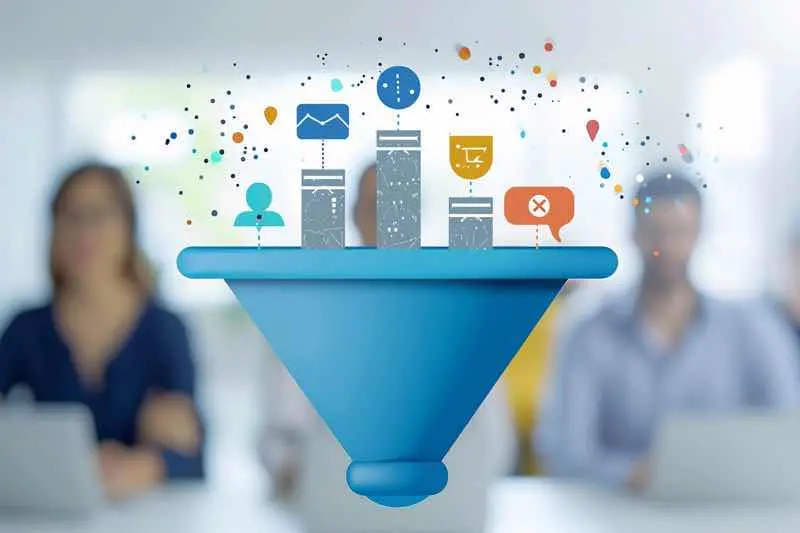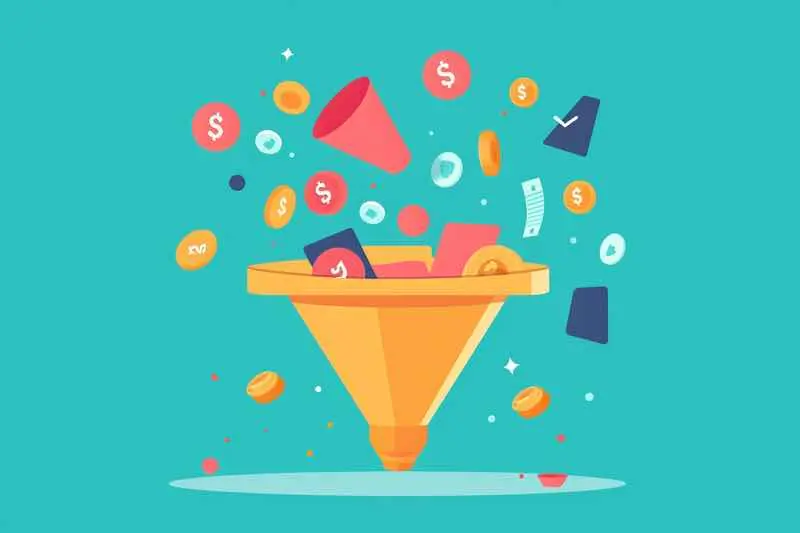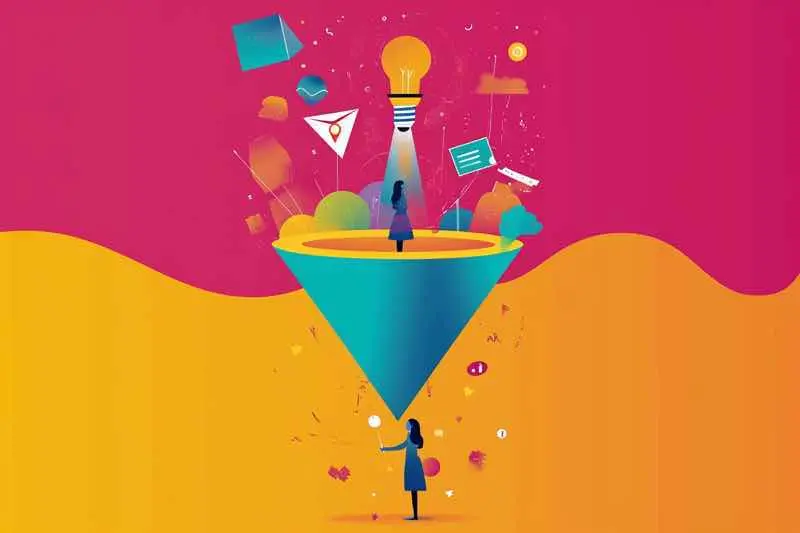Marketing funnels play a pivotal role in mapping the journey of potential customers through various stages, tracking efforts to attract, engage, and ultimately convert them. Understanding the marketing funnel and implementing effective strategies for each stage is crucial for businesses to generate leads and drive conversions. In this comprehensive guide, we will explore the basics of the marketing funnel, its stages, effective strategies for each stage, and common mistakes to avoid. Let’s dive in!
Table of Contents
ToggleKey Takeaways
- Understanding the marketing funnel and its stages is crucial for businesses to effectively attract, engage, and convert potential customers.
- The marketing funnel consists of four stages: awareness, interest, consideration, and conversion.
- Top-of-funnel strategies focus on capturing attention and generating leads, while middle-of-funnel strategies aim to nurture leads and build trust.
- Bottom-of-funnel strategies focus on closing the deal and driving conversions.
- Common mistakes to avoid in the marketing funnel include neglecting the top of the funnel, lack of personalization, and ignoring customer retention.
What is a Marketing Funnel and Why Should You Care?

The Basics of the Marketing Funnel
Marketing funnels are like a roadmap for businesses, guiding potential customers through a series of stages from awareness to conversion. Think of it as a strategic blueprint that helps you navigate the complex world of marketing. By understanding the basics of the marketing funnel, you’ll be equipped with the knowledge to create effective campaigns that drive results. So, let’s dive in and explore the different stages of the marketing funnel!
Why Understanding the Marketing Funnel is Crucial for Your Business
Understanding the marketing funnel is crucial for your business because it provides a strategic blueprint for guiding potential customers through the buying process. It allows you to effectively attract, engage, and convert leads, ultimately driving revenue and growth.
Without a clear understanding of the marketing funnel, businesses may struggle to develop a cohesive and effective marketing strategy that delivers tangible results. By implementing a well-crafted marketing funnel, you can generate a steady stream of qualified leads and efficiently move them from awareness to conversion.
Here are some key reasons why understanding the marketing funnel is crucial:
- Clear Customer Understanding: The marketing funnel helps businesses better comprehend the different steps of a customer’s experience, allowing for tailored and personalized interactions at each stage.
- Effective Allocation of Resources: By targeting the key stages of the marketing funnel, businesses can streamline their resource allocation and focus on areas with the greatest potential for successful conversions.
- Continuous Improvement: Regularly analyzing data and metrics at every stage of the funnel is crucial for determining effectiveness and refining strategies based on insights from analytics and customer feedback.
In summary, understanding the marketing funnel is essential for businesses looking to grow and succeed in today’s competitive landscape. It provides a roadmap for guiding potential customers through their unique journey, ensuring a smooth and effective conversion process.
How the Marketing Funnel Helps You Convert Leads into Customers
The marketing funnel is not just a fancy concept, it’s a powerful tool that can effectively foster leads, establish connections, and ultimately generate conversions. It guides potential buyers through different stages of the buying process, from awareness to conversion. But how exactly does the marketing funnel help you convert leads into customers?
Firstly, the marketing funnel helps you understand your audience better. By analyzing the data at each stage of the funnel, you can gain insights into your customers’ preferences, behaviors, and pain points. This information allows you to tailor your marketing strategies and messages to resonate with your target audience.
Secondly, the marketing funnel helps you nurture leads. Not all leads are ready to make a purchase immediately. In fact, studies show that 96% of website visitors are not ready to buy right away. The funnel provides a framework for lead nurturing, allowing you to deliver the right message at the right time. By providing valuable content, addressing objections, and building trust, you can move leads closer to conversion.
Thirdly, the marketing funnel helps you optimize your marketing efforts. By tracking the progress of leads through each stage of the funnel, you can identify which marketing channels and strategies are most effective in driving conversions. This allows you to allocate your marketing budget smartly and focus on the tactics that yield the best results.
In summary, the marketing funnel is a comprehensive strategy that guides potential buyers through the buying process. It helps you understand your audience, nurture leads, and optimize your marketing efforts. By leveraging the power of the marketing funnel, you can convert leads into paying customers and drive business growth.
The Stages of the Marketing Funnel

Stage 1: Awareness – Attracting Potential Customers
The awareness stage is the first step in the marketing funnel, where the goal is to attract a wide range of people. This is done through various methods such as advertising, social media strategies, and other forms of outreach. The main objective is to make people aware of a specific product or service and introduce them to the brand. To effectively boost brand recognition and attract a wide audience, it is crucial to utilize social media platforms to capture attention and generate interest. Here are some strategies that can be implemented at this stage:
- Content Marketing: Create high-quality content, such as blog posts, videos, and social media posts, that provides value to potential customers and positions your brand as an authority in your industry.
- Search Engine Optimization (SEO): Optimize your website and content to rank higher in search engine results, making it easier for potential customers to find you.
- Advertising: Utilize paid advertising channels, such as Google Ads or social media ads, to reach a larger audience and increase brand visibility.
Remember, at this stage, prospects are not ready to buy yet, so focus on educating them about what you do and how you can help them.
Stage 2: Interest – Engaging and Educating Your Audience
In the interest stage, prospects demonstrate an interest in your product or service. This is the perfect opportunity to provide them with detailed content that helps them gain clarity over what’s right for their business. You can offer resources such as how-to videos, blogs, ebooks, and more. Showcasing your products or services and addressing common objections can also be effective during this stage. Remember, the goal is to keep the prospects engaged and interested in what you have to offer.
Stage 3: Consideration – Convincing Prospects to Choose Your Brand
At the consideration stage, potential customers are evaluating your brand, product, or service. They are comparing your offerings to your competitors and reading reviews from other customers. This is the crucial moment where you need to stand out and convince them to choose your brand. Here are some effective strategies to consider:
- Highlight the unique value proposition of your brand
- Provide compelling and informative content
- Offer personalized recommendations based on their needs
- Showcase positive reviews and testimonials
Remember, at this stage, customers are looking for credibility and reassurance. By implementing these strategies, you can build trust and increase the likelihood of conversion.
Stage 4: Conversion – Turning Leads into Paying Customers
Once you have applied the strategies in the above 3 stages, it’s time to close the deal. It’s the critical point where a qualified lead transitions into a paying customer or completes the desired action, such as making a purchase, signing a contract, or subscribing to a service. This phase signifies the culmination of the entire customer journey, where the efforts invested in lead generation, qualification, and nurturing ultimately result in a successful conversion. It involves guiding the lead through the final steps, addressing any remaining concerns or objections, and facilitating the decision-making process.
Effective Strategies for Each Stage of the Marketing Funnel

Top-of-Funnel Strategies: Capturing Attention and Generating Leads
At the top of the marketing funnel, the focus is on creating awareness about your products or services and enticing individuals to express interest or interact with your brand through various channels. The goal here is to encourage prospects to provide their contact details or engage with your content, allowing you to initiate communication and move them further along the sales funnel.
Strategies for Effective Lead Generation:
- Content Marketing – Create valuable content like blogs and guides to attract visitors and capture lead data.
- SEO – Optimize website content to rank higher in search engines and earn more traffic.
- Paid Ads – Run targeted ads on platforms like Facebook and Google to reach a wider audience.
Remember, the key is to grab attention and generate leads that have the potential to become paying customers. So, make sure your top-of-funnel strategies are compelling, informative, and engaging.
Middle-of-Funnel Strategies: Nurturing Leads and Building Trust
The middle of the funnel (MOFU) is the second stage of the marketing funnel. It is where potential customers who have shown interest in your brand, product, or service move further down the funnel. It is towards becoming a paying customer or taking a desired action. This stage is all about nurturing leads and providing them with the information and resources they need to make an informed decision.
Some effective strategies for nurturing leads at the middle of the funnel include:
- Email Marketing: Send targeted email campaigns to leads. It provides them with helpful information. It can address their pain points and guide them towards making a purchase or taking a desired action.
- Lead Magnets: Offer valuable resources. Examples of such are e-books, white papers, or webinars. You can exchange it for a lead’s contact information. This allows you to continue nurturing the relationship and guide them towards making a purchase.
- Retargeting: Show targeted ads to leads who have visited your website or engaged with your brand. This helps to keep your brand top-of-mind and reminds leads of their interest in your products or services.
By implementing these strategies, you can effectively nurture leads, build trust, and increase the likelihood of converting them into paying customers.
Bottom-of-Funnel Strategies: Closing the Deal and Driving Conversions
Once you have applied the strategies in the above 3 stages, it’s time to close the deal. It’s the critical point where a qualified lead transitions into a paying customer or completes the desired action, such as making a purchase, signing a contract, or subscribing to a service. This phase signifies the culmination of the entire customer journey, where the efforts invested in lead generation, qualification, and nurturing ultimately result in a successful conversion. It involves guiding the lead through the final steps, addressing any remaining concerns or objections, and facilitating the decision-making process to secure the sale or desired action.
Tactics for Enhancing Conversion Rates:
- Offer free trials to encourage product testing.
- Share customer success stories to build trust.
- Provide pricing/product matrices for comparison.
- Bundle offerings/tiers for greater perceived value.
- Highlight ROI and long-term savings.
- Upsell additional products/services.
- Offer limited-time percentages off or payment plans.
- Use visible and persuasive CTAs to guide incentivize readiness to talk to sales with discounts.
Common Mistakes to Avoid in the Marketing Funnel

Neglecting the Top of the Funnel: Why Awareness Matters
Neglecting the top of the funnel can be a costly mistake. Businesses should focus on attracting potential customers to their brand. It is through targeted advertising, content marketing, and social media engagement. By neglecting the top of the funnel, businesses miss out on the opportunity to create brand awareness and reach a wide audience. This can result in a lack of leads and ultimately hinder the success of the marketing funnel.
To avoid this mistake, businesses should implement strategies that capture attention and generate leads at the top of the funnel. This includes tactics such as radio ads, billboard ads, blogs, and social media campaigns. By casting a wide net and reaching consumers through various channels, businesses can increase their chances of attracting potential customers and guiding them through the rest of the marketing funnel.
Lack of Personalization: Tailoring Your Approach to Different Stages
When it comes to the marketing funnel, personalization is key. Tailoring your approach to different stages can make all the difference in converting leads into customers. However, many businesses fall into the trap of neglecting this crucial aspect. They focus on a one-size-fits-all strategy that fails to address the unique needs and preferences of their audience at each stage.
To avoid this mistake, here are some important considerations:
- Understand your audience: Take the time to research and analyze your target market. Gain insights into their demographics, interests, and pain points. This will help you create personalized content that resonates with them.
- Segmentation is key: Divide your audience into segments based on common characteristics. This allows you to tailor your messaging and offers to each group, increasing the chances of conversion.
- Automation with a personal touch: While automation can streamline your marketing efforts, don’t forget to add a personal touch. Use tools that allow you to customize your messages and make them feel more personal.
- Test and optimize: Continuously test different approaches and analyze the results. This will help you identify what works best for each stage of the funnel and make data-driven decisions.
Remember, personalization is not just a buzzword. It’s a powerful strategy that can significantly impact your marketing success. By tailoring your approach to different stages of the funnel, you can create a more engaging and effective customer journey.
Ignoring Customer Retention: The Importance of Post-Purchase Engagement
After a customer makes a purchase, many businesses make the mistake of neglecting the post-purchase stage. However, this is a critical phase that should not be overlooked. It’s not enough to simply acquire new customers; you need to keep them coming back for more. That’s where post-purchase engagement comes in. By implementing effective strategies to engage and retain customers after their initial purchase, you can build brand loyalty, foster lasting connections, and ultimately drive repeat business.
So, how can you ensure that your post-purchase engagement efforts are successful? Here are some key strategies to consider:
- Personalized post-purchase emails: Sending relevant content based on purchase history can boost repeat purchase rates by 15%.
- Loyalty programs and rewards: Encouraging repeat business with incentives and exclusive offers can increase customer retention by 20%.
- Community building and social engagement: Foster connections through forums, groups, and social media interactions, leading to 30% higher brand advocacy.
Remember, the post-purchase stage is not the end of the customer journey. It’s an opportunity to strengthen your relationship with customers and turn them into loyal advocates for your brand. Don’t ignore the importance of post-purchase engagement!
In the world of marketing, there are common mistakes that businesses should avoid in order to optimize their marketing funnel. These mistakes can hinder the success of a marketing campaign and prevent potential customers from progressing through the funnel. One common mistake is not defining the target audience clearly.
Without a clear understanding of who the target audience is, businesses may end up wasting resources on ineffective marketing strategies. Another mistake is neglecting the importance of lead nurturing. Building relationships with leads and providing them with valuable content can significantly increase the chances of conversion. Additionally, failing to track and analyze marketing metrics can make it difficult to identify areas for improvement.
By monitoring key metrics such as conversion rates and customer acquisition costs, businesses can make data-driven decisions to optimize their marketing funnel. To avoid these common mistakes and achieve remarkable success in your marketing efforts, contact us now through our channels. Let’s discuss your business needs and work together to achieve your goals!
Decoding the Future of Funnels
In this comprehensive guide, we have explored the power and importance of marketing funnels in today’s competitive landscape. A well-crafted marketing funnel can guide potential customers through their unique journey, generate qualified leads, and ultimately drive conversions.
By understanding the customer conversion journey and utilizing various techniques, businesses can effectively engage with and reach their target audience. Beyond the funnel, it is crucial to embrace the entire customer journey and provide a seamless experience. So, embrace the power of marketing funnels and embark on a journey towards success!
FAQs
What is a marketing funnel?
A marketing funnel is a visual way of breaking down and understanding the customer conversion journey, stage by stage. It represents the process from initial awareness to final conversion.
Why is understanding the marketing funnel important for businesses?
Understanding the marketing funnel is crucial for businesses because it helps them develop a cohesive and effective marketing strategy that delivers tangible results. It allows businesses to attract, engage, and convert potential customers.
What are the stages of the marketing funnel?
The stages of the marketing funnel are awareness, interest, consideration, and conversion. These stages represent the different steps a customer takes on their journey towards making a purchase.
What are some effective strategies for each stage of the marketing funnel?
For the top-of-funnel stage, strategies include capturing attention and generating leads. For the middle-of-funnel stage, strategies include nurturing leads and building trust. For the bottom-of-funnel stage, strategies include closing the deal and driving conversions.
What are common mistakes to avoid in the marketing funnel?
Common mistakes to avoid in the marketing funnel include neglecting the top of the funnel, lack of personalization, and ignoring customer retention. Awareness, personalization, and post-purchase engagement are all important aspects of a successful marketing funnel.
How can a well-crafted marketing funnel benefit a business?
A well-crafted marketing funnel can benefit a business by generating a steady stream of qualified leads and efficiently moving them from awareness to conversion. It helps businesses effectively engage with and reach targeted customers, leading to increased sales and growth.








































































































